- Home
- »
- Advanced Interior Materials
- »
-
Metal Powder Market Size, Share & Trends Report, 2030GVR Report cover
![Metal Powder Market Size, Share & Trend Report]()
Metal Powder Market Size, Share & Trend Analysis Report By Materials (Ferrous & Non-Ferrous), By Technology (Press & Sinter, MIM, AM), By Application, By Region, And Segment Forecasts, 2024 - 2030
- Report ID: GVR-3-68038-948-7
- Number of Report Pages: 100
- Format: PDF, Horizon Databook
- Historical Range: 2018 - 2022
- Forecast Period: 2024 - 2030
- Industry: Advanced Materials
Metal Powder Market Size & Trends
The global metal powder market size was estimated at USD 6.29 billion in 2023 and is anticipated to expand at a compound annual growth rate (CAGR) of 7.3% from 2024 to 2030. Increasing demand for additive manufacturing (AM) components from the aerospace industry is driving market growth. AM technology being an extremely reliable system, enables manufacturing of highly complex designs and geometry that cannot be made from other processes. Owing to increase in demand for AM from aerospace & defense industries key players are investing to expand their capacity.
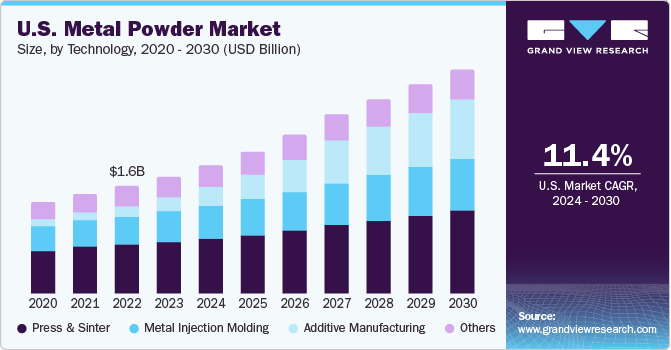
Product-based components are extensively used in various end-use industries, including automotive, industrial, electronics, firearms, and healthcare. Powder metallurgy is capable of producing structural, magnetic, & next-generation high-performance parts and tribological components. Growth in end-use industries is expected to propel demand for powdered parts in U.S. during forecast period.
Rising geopolitical tensions have pushed countries to increase and upgrade their aerospace & defense equipment, which is expected to augment consumption of metal powder-based components in coming years. For instance, in December 2022, German government approved spending of EUR 10 billion (USD 10.83 billion) to purchase F-35 fighter jet from U.S.
Aerospace & defense segment is an early adopter of additive manufacturing. Companies such as NASA, SpaceX, and other aerospace organizations are benefitting from AM technology as it facilitates production of prototypes with high geometric accuracy in less time and ensures minimal wastage of material. Owing to the aforementioned reasons, several aerospace & defense companies are ordering metal AM printers.
Market Concentration & Characteristics
The global metal powder market is characterized by presence of established players including GKN PLC, Sandvik AB, and Höganäs AB. Companies use an established distribution and sales network to connect with their customers across different regions. New product development and competitive pricing are some of the key focus areas of the manufacturers to strengthen their position in the market.
Growth of lightweight vehicles, technological advancements, and raw material costs influence the price of products along with macroeconomic factors. Market players formulate their strategies in line with the above factors along with the performance of key application industries namely automotive, oil & gas, aerospace & defence, and medical.
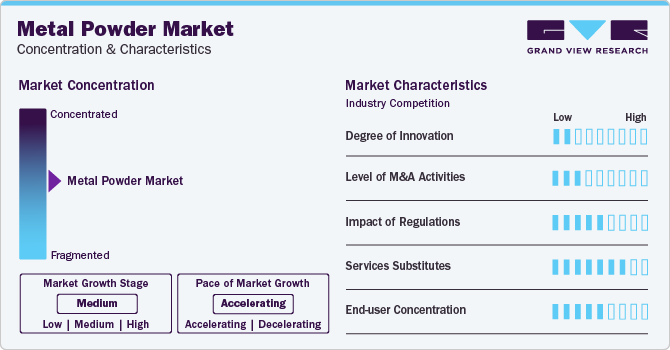
Key players are using mergers and acquisitions activity across the globe, as large players acquire minority stakes in smaller producers that have advantages like advanced technology, efficient processes or a solid presence in the market. Promotion of innovation, lower costs and enhanced synergies within operations is also an essential element to enhance these activities in the industry.
Materials used in AM to produce a wide range of end-use products costs more than those used in traditional methods. For instance, stainless steel as raw material in AM costs over USD 8 per square centimetre compared to the ones used in traditional manufacturing. Thus, high manufacturing costs, slightly obstructs the growth of the AM market.
Application Insights
Automotive segment accounted for largest revenue share of 62.0% in 2023. In the automotive industry, various parts and components of engines, chassis, and transmissions are manufactured using powder metallurgy technology, which is propelling the demand for metal powder.
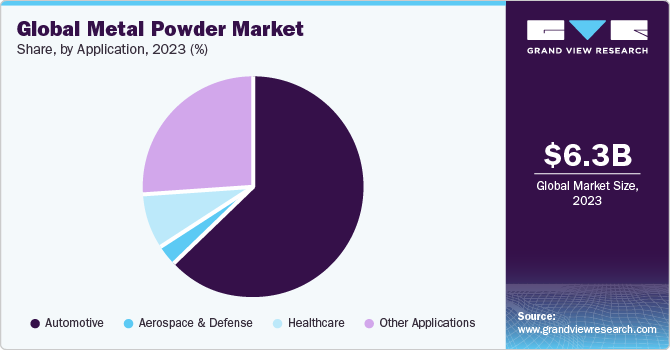
The aerospace & defense segment is expected to register a growth rate of 6.0% across the forecast period. The segment is an early adopter of AM. The technology is helping manufacturers to develop complex parts and prototypes. Due to this, aerospace & defense companies are purchasing new AM printers. For instance, in September 2023, GKN Aerospace ordered two 3D- printing systems from Nikon SLM Solutions.
The healthcare sector is driven by increased awareness among consumers of the disease, together with a rise in consumer willingness to pay more for end products. In addition, the application of powder metal technology in health sector is driving this segment as it manufactures inserting plates, foot adapters, blackling plates, surgical blades, forceps, graspers, and Blacking Hooks.
Material Insights
Ferrous was largest segment and accounted for a revenue share of over 69.0% in 2023. It encompasses a range of steel types and their alloys, along with iron and alloying elements such as molybdenum, nickel, and chromium. Steel is a cost-effective material that can be blended with other materials like bronze and utilized in AM.
Non-ferrous segment consists of aluminum, copper, zinc, titanium, tungsten, magnesium, and others. Aluminum's desirable traits, such as good strength and lightweight nature, are anticipated to increase its demand. It is widely used in the manufacturing of equipment, including functional parts and cycles. Aluminum-based equipment is produced using a 3D printing process called direct metal laser sintering.
Rising demand for titanium implants in the healthcare industry is projected to fuel the growth of this segment. In order to address deformities in the bones, human skull, and vertebrae, companies Novax DMA and CEIT Biomedical Engineering have started manufacturing medical implants made of titanium.
Regional Insights
Asia Pacific accounted for a revenue share of over 34.0% in 2023 of the global market. In the automotive and aviation sectors, the region saw a high demand for products. The region's market is being driven by the presence of small and midsized component producers for press and sintered products, coupled with increasing demand for AM.
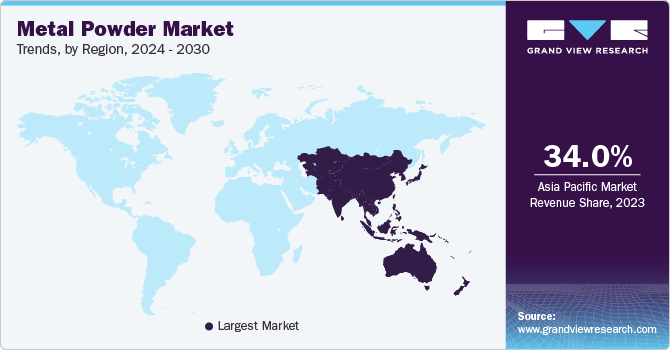
In terms of revenue, North America is projected to expand at a growth rate of 6.5% from 2024 to 2030. In particular, demand for different sintered parts in transmissions and engines has been reduced as a result of the increasing popularity of vehicles that are both energy-efficient and hybrids. Nevertheless, the market vendors are expected to have lucrative opportunities over the next few years through powder forging technology. According to the Federation of Metal Powder Industries, almost 30% of automotive coupling rods are produced through powder forging processes worldwide.
Technology Insights
The largest technology segment was press and sinter, which accounted for more than 48.0% revenue share in 2023. Press & sinter is a conventional powder metallurgy process. It is economic and produces near-net-shape components. In order to manufacture a green compact, it involves heat treatment or compaction at temperatures lower than the melting point of metal.
This mechanical bonding of particles contributes to increasing component strength. In addition, green compacts are sintered in a controlled atmosphere where they undergo metallurgical bonding to form their finished components. In order to attain accurate tolerances and a favorable finish of the surface, additional tasks such as plating, repression, or finishing is carried out.
MIM technology has gained significant importance in the component industry for the past 20 years, This process is based on shaping and sintering of particles, similar to that used for press or sinter. High volumes of complicated shaped parts, with high manufacturing accuracy, can be produced through this method. There are different steps in the MIM process, e.g., mixing or processing of raw materials, injection molding, removal of bindery, and Sintering.
Key Companies & Market Share Insights
Some of the key players operating in the market include GKN PLC and Sandvik AB:
-
GKN PLC is one of the leading producers and suppliers in the industry and also produces atomized metal powders for various applications. The company annually produces around 250,000 tons of powder.
-
Sandvik AB has more than 45 years of metal powder expertise and produces more than 400 different grades of alloys of metal powder.
MolyWorks Materials Corporation, Inc. is one of the emerging market participants.
-
MOLYWORKS Materials Corporation is one the emerging global manufacturers of sustainable metal powders. In 2015, the company invented “The Greyhound", a compact, alloy agnostic, upcycling system. This system produces metal powder from metal waste streams of used powder, failed builds, old parts, and machined waste.
-
Avimetal AM Tech Co., Ltd, has advanced powder manufacturing technologies such as electrode induction gas atomization, plasma atomization, and vacuum induction gas atomization.
Key Metal Powder Companies:
- Advanced Technology & Materials Co., Ltd
- CRS Holdings Inc.
- GKN PLC
- Hoganas AB
- MolyWorks Materials Corporation
- POLEMA
- Rio Tinto Metal Powders
- Rusal
- Sandvik AB
Recent Developments
-
In November 2023, 6K Additive acquired Global Metal Powder company. This acquisition is expected to help the company in expansion of refractory powder production and sustainable product development.
-
In October 2023, Sandvik AB announced that it is going to acquire Buffalo Tungsten, Inc. The acquisition is expected to allow Sandvik to increase its market presence in the U.S., as well as strengthen its regional capabilities within the component manufacturing value chain.
-
In July 2023, Collins Aerospace announced its plan to invest USD 14.0 million for expansion its AM facility. This expansion of the facility will enable the installation of multiple new 3D metal printers that ensures the development of the additive manufacturing potentials of the company.
Metal Powder Report Scope
Report Attribute
Details
Market size value in 2024
USD 6.92 billion
Revenue forecast in 2030
USD 10.18 billion
Growth rate
CAGR of 7.3% from 2024 to 2030
Base year for estimation
2023
Historical data
2018 - 2022
Forecast period
2024 - 2030
Report Updated
January 2024
Quantitative units
Volume in Kilotons, Revenue in USD million, and CAGR from 2024 to 2030
Report coverage
Volume forecast, revenue forecast, competitive landscape, growth factors, and trends
Segments covered
Material, technology, application, region
Regional scope
North America; Europe; Asia Pacific; Central & South Africa; Middle East & Africa
Country scope
U.S.; Germany; Italy; Spain; China; Japan; India; South Korea; Brazil
Key companies profiled
MolyWorks Materials Corporation; Advanced Technology & Materials Co., Ltd.; GKN PLC; Hoganas AB; POLEMA; Rio Tinto Metal Powders; Rusal; Sandvik AB; CRS Holdings Inc.; Liberty House Group
Customization scope
Free report customization (equivalent up to 8 analysts working days) with purchase. Addition or alteration to country, regional & segment scope.
Pricing and purchase options
Avail customized purchase options to meet your exact research needs. Explore purchase options
Global Metal Powder Market Report Segmentation
This report forecasts revenue and volume growth at country & regional levels and provides an analysis of the industry trends in each of the sub-segments from 2018 to 2030. For this study, Grand View Research has segmented the global metal powder market report based on material, technology, application, and region:
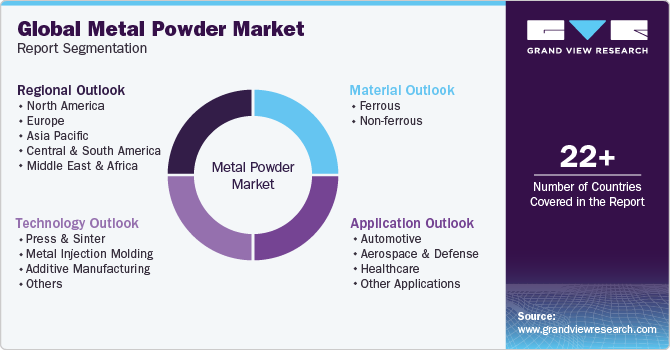
-
Material Outlook (Volume, Kilotons; Revenue, USD Million; 2018 - 2030)
-
Ferrous
-
Non-ferrous
-
-
Technology Outlook (Volume, Kilotons; Revenue, USD Million; 2018 - 2030)
-
Press & Sinter
-
Metal Injection Molding
-
Additive Manufacturing
-
Others
-
-
Application Outlook (Volume, Kilotons; Revenue, USD Million; 2018 - 2030)
-
Automotive
-
Aerospace & Defense
-
Healthcare
-
Other applications
-
-
Regional Outlook (Volume, Kilotons; Revenue, USD Million; 2018 - 2030)
-
North America
-
U.S.
-
-
Europe
-
Germany
-
Italy
-
Spain
-
-
Asia Pacific
-
China
-
Japan
-
South Korea
-
India
-
-
Central & South America
-
Brazil
-
-
Middle East & Africa
-
Frequently Asked Questions About This Report
b. The global metal powder market size was estimated at USD 6.29 billion in 2023 and is expected to reach USD 6.92 billion in 2024.
b. The global metal powder market is expected to grow at a compound annual growth rate of 7.3% from 2024 to 2030 to reach USD 10.18 billion by 2030.
b. Press & sinter dominated the metal powder market with a revenue share of 48.4% in 2023, owing to its increasing usage of sintered products in automobiles.
b. Some of the key players operating in the metal powder market include GKC Plc, Sandvik Ab, Hoganas AB, Rusal and Rio Tinto Metal Powders.
b. The key factors that are driving the metal powder market include increasing penetration of additive manufacturing in the healthcare and aerospace & defense sector and the growth of the automotive sector.
Share this report with your colleague or friend.
![gvr icn]()
NEED A CUSTOM REPORT?
We can customize every report - free of charge - including purchasing stand-alone sections or country-level reports, as well as offer affordable discounts for start-ups & universities. Contact us now
![Certified Icon]()
We are GDPR and CCPA compliant! Your transaction & personal information is safe and secure. For more details, please read our privacy policy.
We are committed towards customer satisfaction, and quality service.
"The quality of research they have done for us has been excellent."





